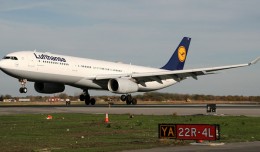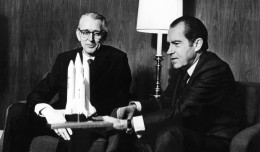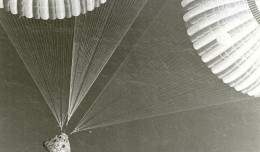
S7 took on this bright scheme after changing their name from Siberia Airlines in 2006. (Photo by Gordon Gebert Jr.)
2008 – Philippine Airlines’ regional carrier PAL Express began operations with 8 daily flights between Manila and Malay with Bombardier Dash-8-400 turboprops.
2007 – Kenya Airways Flight 507, a Boeing 737-800 (5Y-KYA) scheduled to fly to Nairobi, Kenya, crashes just after takeoff from Douala, Cameroon. All 114 occupants are killed after the pilot departs without clearance and then does not realize the aircraft is banking hard to the right in time for correction due to improper auto-pilot inputs. The aircraft strikes a forested swamp a few miles to the south of the airport, where a reporter would find one year later that aircraft wreckage and human remains are still present.
2007 – Eos Airlines begins flights from London Stansted to Newark Liberty International Airport with their 48-seat, all-business class Boeing 757-200 aircraft.
2006 – Siberia Airlines renames itself to S7 Airlines and repaints its to a bright green, which is partly so the aircraft can be spotted among the tundra of Russia in the event of a crash.
2004 – Air France and KLM Royal Dutch Airlines merge, forming the creative name of Air France-KLM. The newly combined Paris-based carrier creates a combined total of flights to 225 destination worldwide.
1998 – A Peruvian Air Force Boeing 737-200 (FAP-351) operating on lease to Occidental Petroleum crashes in a thunderstorm while on a non-directional beacon (NDB) approach, killing 75 of the 88 aboard.
1993 – Jet Airways begins commercial operations with four Boeing 737-300 airliners.
1990 – A Douglas DC-6 (N84BL) operated by Aerial Transit Company crashes after takeoff from Guatemala City, Guatemala, killing all 3 on the aircraft and an additional 24 on the ground. The cargo flight, destined for Miami, develops engine trouble and strikes the ground while trying to make its way back to the airport.
1983 – Eastern Airlines Flight 855, a Lockheed L-1011 Tristar (N334EA), avoids disaster after experiencing trouble on all three of its engines on a flight from Miami to Nassau, Bahamas. In a move that would later be pivotal to their survival, the crew shuts down the #2 engine after it receives a low oil pressure warning light while descending through 15,000ft. The crew decides to return to their Miami base on the remaining two engines, which should not be a problem until the same light illuminates for engines #1 and #3, both of which soon flame out five minutes apart. Since the #2 tail engine is the only one intentionally shut down as a precaution, it still has enough oil to restart as the aircraft glides toward the ocean through 4,000ft, preparing the ditch. Miraculously, the Tristar is able to make a one-engine landing at Miami, saving the lives of all 172 people aboard. The cause is attributed to mechanics who failed to apply all the O-ring seals on the master chip detector assemblies, leading to the loss of lubrication on the engines.
1972 – Alitalia Flight 112, a flight from Rome to Palermo, Italy, crashes into Mount Longa while approaching at night. The Douglas DC-8-43 (I-DIWB “Antonio Pigafetta”) had strayed from the published approach pattern, killing all 115 onboard.
1972 – Western Airlines Flight 407 is hijacked by a 21-year-old Michael Lynn Hansen, who had sneaked on a .38 caliber pistol in a hallowed book, just after departure from Salt Lake City, Utah. Demanding to go to North Vietnam, the Boeing 737-200 first stops at its scheduled destination of Los Angeles for fuel. Hansen then changes his mind and says he’d rather go to Cuba, and a stop is made in Tampa for more gas before successfully continuing on to Havana. He would be extradited back to the United States in 1975.
1972 – Eastern Airlines Flight 175 is hijacked by a man named Richard Hahneman after departing Allentown, PA, demanding $303,000 and 6 parachutes. After receiving the ransom after landing in Washington-Dulles, Hahneman insists on flying to New Orleans for fuel before heading to Honduras, where he would successfully parachute out. He is caught by Honduran soldiers a few days later.
1968 – The twin-engine Grumman Gulfstream II becomes the first executive jet to cross the Atlantic Ocean. The 3,500-mile trip to London departs from Teterboro, New Jersey.
1965 – Iberia Flight 401 crashes on its second approach to runway 30 at Tenerife, Spain. The Lockheed L-1049 Super Constellation (EC-AIN), attempting landing in weather below minimums, strikes construction equipment while initiating its second go-around. Of the 49 onboard, 30 perish.
1961 – Alan Shepard, aboard the Freedom 7 spacecraft, becomes the first American and the second human to enter space. The 15-minute flight sent him 116 miles above the Earth.
1958 – A Royal Air Force Miles Marathon T.2 (XA253) crashes after landing at Topcliffe RAF Station in the UK after the crew accidentally retracts the landing gear instead of raising the flaps.
1930 – Amy Johnson begins her 19-day journey from England to Australia in a de Havilland D.H.60 Moth, becoming the first woman to do so.







